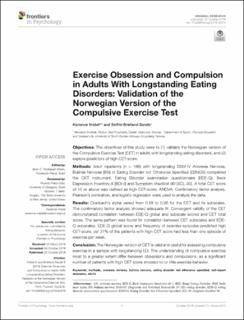| dc.contributor.author | Vrabel, Kari-Anne | |
| dc.contributor.author | Bratland-Sanda, Solfrid | |
| dc.date.accessioned | 2020-03-17T13:37:32Z | |
| dc.date.available | 2020-03-17T13:37:32Z | |
| dc.date.created | 2019-11-14T09:42:29Z | |
| dc.date.issued | 2019 | |
| dc.identifier.citation | Frontiers in Psychology. 2019, 10 (2370). | en_US |
| dc.identifier.issn | 1664-1078 | |
| dc.identifier.uri | https://hdl.handle.net/11250/2647210 | |
| dc.description | This is an open-access article distributed under the terms of the Creative Commons Attribution License (CC BY). The use, distribution or reproduction in other forums is permitted, provided the original author(s) and the copyright owner(s) are credited and that the original publication in this journal is cited, in accordance with accepted academic practice. No use, distribution or reproduction is permitted which does not comply with these terms. | en_US |
| dc.description.abstract | Objectives: The objectives of this study were to (1) validate the Norwegian version of the Compulsive Exercise Test (CET) in adults with longstanding eating disorders, and (2) explore predictors of high CET-score. Methods: Adult inpatients (n = 166) with longstanding DSM-IV Anorexia Nervosa, Bulimia Nervosa (BN) or Eating Disorder not Otherwise Specified (EDNOS) completed the CET instrument, Eating Disorder examination questionnaire (EDE-Q), Beck Depression Inventory-II (BDI-II) and Symptom checklist-90 (SCL-90). A total CET score of 15 or above was defined as high CET-score. ANOVA, Confirmatory factor analysis, Pearson’s correlation, and logistic regression were used to analyze the data. Results: Cronbach’s alpha varied from 0.68 to 0.96 for the CET and its subscales. The confirmatory factor analysis showed adequate fit. Convergent validity of the CET demonstrated correlation between EDE-Q global and subscale scores and CET total score. The same pattern was found for correlation between CET subscales and EDE-Q subscales. EDE-Q global score and frequency of exercise episodes predicted high CET-score, yet 21% of the patients with high CET score had less than one episode of exercise per week. Conclusion: The Norwegian version of CET is valid and useful for assessing compulsive exercise in a sample with longstanding ED. The understanding of compulsive exercise must to a greater extent differ between obsessions and compulsions, as a significant number of patients with high CET score showed no or little exercise behavior. | en_US |
| dc.language.iso | eng | en_US |
| dc.rights | Navngivelse 4.0 Internasjonal | * |
| dc.rights.uri | http://creativecommons.org/licenses/by/4.0/deed.no | * |
| dc.title | Exercise obsession and compulsion in adults with longstanding eating disorders: Validation of the Norwegian version of the compulsive exercise test | en_US |
| dc.type | Peer reviewed | en_US |
| dc.type | Journal article | en_US |
| dc.description.version | publishedVersion | en_US |
| dc.rights.holder | © 2019 Vrabel and Bratland-Sanda. | en_US |
| dc.source.pagenumber | 8 | en_US |
| dc.source.volume | 10 | en_US |
| dc.source.journal | Frontiers in Psychology | en_US |
| dc.source.issue | 2370 | en_US |
| dc.identifier.doi | 10.3389/fpsyg.2019.02370 | |
| dc.identifier.cristin | 1747401 | |
| cristin.ispublished | true | |
| cristin.fulltext | original | |
| cristin.qualitycode | 2 | |

